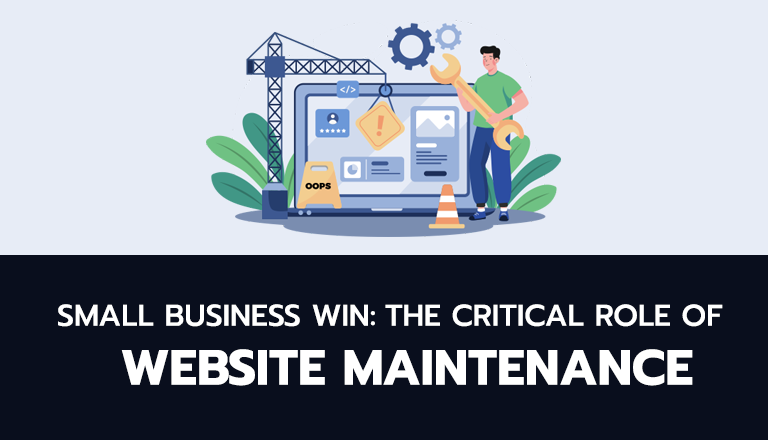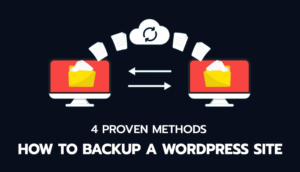What is Website Maintenance?
Website upkeep involves a range of activities to ensure your website is always updated, secure, and performing at its best. It includes:
- Regular updates to software, themes, and plugins.
- Frequent security monitoring and vulnerability assessments.
- Routine backups of website data.
How It Differs from Website Development
Website maintenance and website development are two distinct aspects of managing a website, each with its own focus and objectives.
Website maintenance is a continuous process. It’s all about making sure the current website stays up-to-date, secure, and functions properly. This ongoing care is crucial for keeping the website reliable and safe for users.
On the other hand, website development is typically project-based. This involves either building a new website from scratch or making significant changes to an existing one. Development can include creating new features, redesigning the site for a fresh look, or overhauling the entire site to improve user experience or add new functionality. Development projects are often more intensive and require a significant amount of planning, design, and testing before they go live.
Types of Website Maintenance Tasks
Routine Updates and Security Checks
- Periodically updating the website’s CMS, themes, and plugins.
- Conducting regular security audits to prevent vulnerabilities.
Content Management and SEO Optimization
- Regularly updating and adding fresh content.
- Optimizing the website for search engines through updates to meta tags, keywords, and content.
Performance Monitoring and User Experience Improvements
- Continuously monitoring the website’s loading speed and responsiveness.
- Implementing design and navigational improvements for better user experience.
Benefits of Regular Website Maintenance for Small Businesses
For small businesses, consistent website upkeep is not only technically essential but also a key strategic resource.
Let’s delve into the main benefits.
1. Enhancing Website Security
Regularly updating your website and checking its security helps keep it safe from online threats. This not only protects your business but also keeps your customers’ information secure. Having a safe website makes customers trust you more, which is important for a good, lasting business relationship.
2. Boosting Online Visibility and SEO
Search engines favor websites that are regularly updated with fresh, relevant content and secure, fast-loading pages. Doing regular SEO updates as part of your maintenance can help your website show up better and rank higher in search results.
Additionally, continually updating your website’s content keeps it interesting and up-to-date for your audience. Adding new content can bring in new visitors and keep your current customers coming back for more.
3. Improving User Experience and Engagement
Keeping your website well-maintained with quick loading times and great performance is key to a good user experience and lower bounce rates. It’s important to make sure every feature and link works right for smooth interaction. Regularly updating your site for mobile use ensures it’s easy to use on any device, which is crucial since a lot of web traffic now comes from mobile devices. Responsive design is a must in today’s mobile-first world.
Developing a Website Maintenance Strategy
Creating a good website maintenance plan is crucial for keeping a small business’s online presence running smoothly and lasting a long time. It’s really important to customize this plan to fit your particular needs to get the most out of it.
Identifying Your Business Specific Needs
Implementing a Maintenance Schedule
For effective website maintenance, it’s suggested to execute tasks on a monthly, quarterly, and annual basis.
- Monthly tasks should include software updates, security checks, and content reviews.
- Quarterly tasks can involve more in-depth performance analysis and SEO optimization.
- Annual tasks might include a comprehensive review of the website design and user experience.
To stay organized and efficient, create detailed checklists for each set of tasks to make sure you don’t miss anything. Using reminders and scheduling tools can also help you keep up with your maintenance plan without falling behind.
Overcoming Challenges in Website Maintenance
Maintaining a website can be tough for small businesses, especially when it comes to budget and technical know-how. However, addressing these challenges is important to keep your online presence strong and safe.
Budgeting for Maintenance
For cost-effective website maintenance, explore options like open-source tools for basic tasks and bundled services from hosting providers, which can offer tools at a reduced cost.
It’s important to balance quality and affordability: prioritize crucial maintenance tasks to make the most of your budget.
Consider the long-term value by weighing the cost of potential downtime or security issues against the expense of regular upkeep.
Technical Challenges and Solutions
To tackle common technical issues with your website, it’s helpful to stay informed through online resources and community forums. Even a basic understanding of your website’s Content Management System (CMS) can enable you to address minor problems on your own.
For non-technical owners, there are user-friendly maintenance tools available, and online tutorials and guides can be valuable resources. These tools and resources help build your technical knowledge and confidence, making it easier to manage maintenance tasks independently.
Outsourcing vs. In-House Maintenance
For small businesses, deciding between outsourcing website maintenance and managing it in-house is a strategic choice. Each option has its advantages and considerations, depending on your business’s capabilities and needs.
Pros and Cons of Each Approach
Evaluating In-House Capabilities
- Pros: Handling website maintenance in-house gives you more control over every aspect of the process, which can lead to lower overall costs. It also allows for quicker responses to minor updates or issues that arise.
- Cons: However, it requires your team to have sufficient technical skills. It can be a time-consuming endeavor, especially for complex issues, and you might not have access to the specialized expertise that some tasks require.
When to Consider Outsourcing
- Pros: Outsourcing your website maintenance means you have access to a team with expert skills and experience. This ensures comprehensive maintenance services and frees up your time to focus on other core business activities.
- Cons: The downside is that it can be more costly than managing it in-house. Additionally, outsourcing means you have less direct control over the maintenance process, which might not always align with your immediate needs or schedule.
Finding the Right Maintenance Partner
Criteria for Choosing a Maintenance Service
- Look for providers with experience in your specific website platform and industry.
- Check their reputation, customer reviews, and case studies to gauge their reliability and effectiveness.
- Opt for flexible contracts that allow for scalability and adjustments as your business evolves.
Conclusion
Regular website maintenance is a critical component of a small business’s digital strategy. It ensures that the website remains a robust tool for marketing, sales, and customer engagement, adapting to the evolving digital landscape.
Proactively managing your website’s maintenance can prevent unforeseen issues, safeguard your online presence, and support your business’s growth and sustainability. Whether it’s through in-house efforts or outsourcing, a well-maintained website is an invaluable asset in today’s competitive business environment.
Comprehensive FAQ Section
This section aims to address common questions about website maintenance, providing small business owners with essential insights for effective online presence management.
- How often should a small business perform website maintenance?
Routine maintenance like updates and backups should be done monthly. More comprehensive reviews, such as performance audits and SEO optimization, can be scheduled quarterly or biannually. - How does regular website maintenance benefit SEO?
Regular maintenance, especially content updates and site speed optimization, can improve search engine rankings, as search engines favor sites that are frequently updated and perform well. - How much should a small business budget for website maintenance?
Budgeting depends on the complexity of the website. On average, small businesses might allocate between 2-5% of their total revenue to website maintenance. - Should a small business handle website maintenance in-house or outsource it?
This depends on the business’s technical expertise and resources. In-house maintenance offers more control, while outsourcing can provide expert skills and save time. - How can a non-technical business owner manage website maintenance effectively?
Non-technical owners can use user-friendly tools for basic maintenance tasks and consider outsourcing more complex aspects like security monitoring and technical SEO. - What should a website maintenance plan include for an e-commerce site?
For e-commerce sites, the maintenance plan should include regular security checks, payment gateway functionality tests, product and inventory updates, and performance optimization.






Share Your Thoughts: